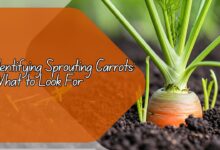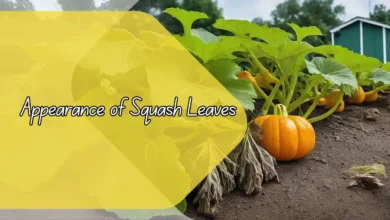
What Do Squash Leaves Look Like?
A common question among gardeners is what do squash leaves look like. In this article, we will explore the distinct characteristics of squash leaves, including their shape, color, texture, and size. By the end of this article, you will be able to easily identify squash leaves in your garden and distinguish them from other plant leaves.
Distinctive Features of Squash Leaves:
- Shape and Size: Squash leaves are typically large and broad, with a distinct shape that is easy to recognize.
- Color and Texture: The leaves are usually dark green in color, with a slightly fuzzy texture on the surface. The veins of the leaves are prominent and run throughout, giving the leaves a unique appearance.
- Serrated Edges: The edges of squash leaves are often serrated, adding to their overall visual appeal.
In terms of size, squash leaves can vary depending on the specific variety of squash plant. However, most squash leaves are quite large, ranging from 8 to 12 inches in diameter. This size, coupled with their distinct features, makes squash leaves easy to spot in a garden setting.

How to Identify Squash Leaves in Your Garden:
One of the key differences between squash leaves and other plant leaves is their size and shape. Squash leaves are typically much larger and broader than leaves of other plants, making them stand out in a garden.
Additionally, the dark green color and fuzzy texture of squash leaves set them apart from other plant leaves.
Another distinguishing feature of squash leaves is their serrated edges, which are not commonly found in many other plant species. These serrated edges give squash leaves a unique appearance that is easy to identify.
Overall, the combination of size, color, texture, and shape makes squash leaves distinct from other plant leaves.

Importance of Squash Leaves for the Plant:
Squash leaves play a crucial role in the health and growth of the plant. One of the main functions of squash leaves is photosynthesis, the process by which plants convert sunlight into energy.
Squash leaves contain chlorophyll, a pigment that absorbs sunlight and allows the plant to produce food through photosynthesis.
In addition to photosynthesis, squash leaves also help regulate the plant’s temperature and provide protection against pests and diseases.
The large surface area of squash leaves allows for efficient cooling of the plant during hot weather, while the fuzzy texture can deter insects from feeding on the leaves. Overall, squash leaves are essential for the plant’s overall well-being and growth.

Caring for Healthy Squash Leaves:
Proper care of squash leaves is essential for the health and productivity of the plant. One of the most important steps in caring for squash leaves is to ensure they receive an adequate amount of sunlight.
Squash plants thrive in full sun, so be sure to plant them in a location that receives at least 6-8 hours of sunlight per day.
In addition to sunlight, squash leaves also require regular watering and fertilization. Be sure to water the plant deeply, allowing the water to reach the roots of the plant. Fertilize the plant with a balanced fertilizer every 2-3 weeks to provide essential nutrients for healthy leaf growth.
Lastly, be on the lookout for any signs of pests or diseases on the leaves and take prompt action to address them.

Conclusion
In conclusion, squash leaves are easy to identify in a garden setting due to their distinct characteristics, including shape, color, texture, and size. By understanding the unique features of squash leaves, you can care for your plants more effectively and ensure their health and productivity.
Remember to provide adequate sunlight, water, and nutrients to your squash leaves, and watch for any signs of pests or diseases to keep your plants thriving.
FAQs
What are some common pests that can affect squash leaves?
Common pests that can affect squash leaves include squash bugs, cucumber beetles, and aphids. These pests can feed on the leaves, causing damage and potentially affecting the overall health of the plant. Keep an eye out for these pests and take appropriate measures to control their populations.
How can I prevent diseases from affecting my squash leaves?
To prevent diseases from affecting your squash leaves, be sure to avoid overhead watering, as this can create humid conditions that promote disease development. Additionally, practice crop rotation and plant disease-resistant varieties to reduce the risk of disease. Regularly inspect your plants for any signs of disease and remove any affected leaves promptly.
Can I eat squash leaves?
While the fruit of the squash plant is commonly consumed, the leaves are not typically eaten. Squash leaves can contain bitter compounds that may not be palatable. However, some cultures do use squash leaves in cooking, so it is recommended to research proper preparation methods if you are interested in using squash leaves as a culinary ingredient.
How can I promote healthy leaf growth in my squash plants?
To promote healthy leaf growth in your squash plants, ensure they receive adequate sunlight, water, and nutrients. Prune any damaged or diseased leaves to encourage new growth and improve air circulation around the plant. Regularly fertilize the plants with a balanced fertilizer to provide essential nutrients for leaf development.
Are squash leaves toxic to pets?
Squash leaves are not typically toxic to pets, but it is always best to exercise caution when allowing pets near plants. Some pets may be sensitive to certain compounds found in plants, so it is recommended to research any potential risks before allowing pets to come into contact with squash leaves. If you suspect your pet has ingested any part of a plant, contact a veterinarian immediately for advice.








